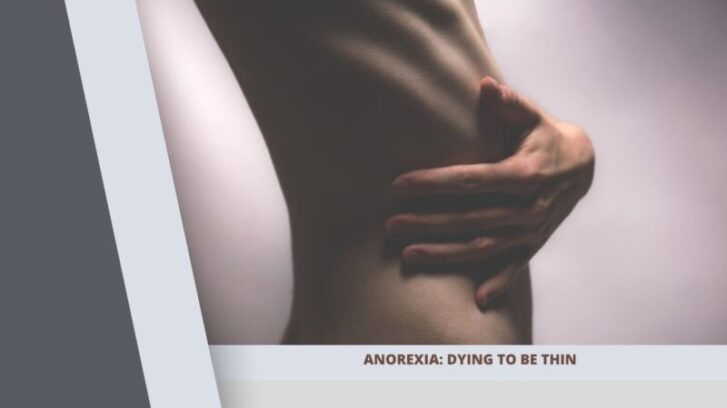Often referred to simply as anorexia, is a potentially life-threatening eating disorder characterized by an intense fear of gaining weight and a distorted body image, leading individuals to self-impose starvation or engage in excessive exercise.
Those suffering from this condition persistently attempt to lose weight or refuse to gain weight, even when they are underweight.
Several misconceptions surround nervosa. Many perceive it as a “choice” or “lifestyle,” while it’s actually a serious mental health condition. Others falsely believe that people with anorexia are always visibly underweight; however, anorexia can affect individuals of all shapes, sizes, and weights.
Some also think it’s solely a “young woman’s disorder,” but this condition affects all genders and ages.
The Diagnostic and Statistical Manual of Mental Disorders (DSM-5) sets the criteria for diagnosing anorexia nervosa, which include restricting food intake to below the requirements of the body, leading to a significantly low body weight, intense fear of gaining weight or becoming fat, and a distorted perception of one’s body weight or shape.
The Root Causes of Anorexia
Psychological factors are central to the development of anorexia. Low self-esteem, perfectionism, and high levels of anxiety are common traits among people with anorexia. Feelings of control or the need for control can also contribute, as controlling food intake can be seen as a means to gain control.
Environmental factors like societal and peer pressure to be thin can contribute to the development of it. Western culture often equates thinness with beauty, success, and worth, which can drive vulnerable individuals towards disordered eating. Traumatic experiences, such as physical or sexual abuse, can also lead to anorexia.
Research indicates that genetics play a role in anorexia, suggesting it can run in families. Studies on twins have shown that if one has anorexia, the other is likely to develop it as well. Certain changes in brain structure and chemistry may also be factors.
Physical Effects of Anorexia
In the short-term, anorexia can cause noticeable weight loss, fatigue, dizziness, insomnia, irregular periods or amenorrhea in women, and an aversion to eating in front of others. It can also result in visible changes, such as thinning hair, dry skin, and a bluish tint to the fingers from poor circulation.
If untreated, anorexia can lead to serious long-term physical effects like osteoporosis due to bone loss, kidney and liver damage, low blood pressure, and heart problems due to malnutrition. Gastrointestinal problems, such as constipation and bloating, are common, and in severe cases, there can be a risk of multi-organ failure.
It has the highest mortality rate among psychiatric disorders, largely due to physical complications associated with severe malnutrition, including cardiac arrest. Additionally, individuals with anorexia are at a higher risk of suicide.
Psychological Impact
It does not just impact the body; it significantly affects mental health as well. Individuals with often experience severe emotional distress, depression, and anxiety. The obsessive preoccupation with weight and body shape can be mentally exhausting and interfere with daily functioning.
Research shows a strong correlation between anorexia and other mental health disorders. It is not uncommon for those suffering from it to also struggle with anxiety disorders, depression, obsessive-compulsive disorder (OCD), or substance abuse.
It can lead to emotional consequences, such as isolation from friends and family due to the individual’s focus on food and weight control. There can also be feelings of shame, guilt, and fear associated with eating, leading to further emotional distress and psychological harm.
Societal Pressure
Media plays a significant role in shaping societal beauty standards, often portraying thinness as desirable. This can result in individuals developing negative body image and low self-esteem, making them susceptible to eating disorders like anorexia.
Social media platforms can exacerbate comparison culture, with constant exposure to images of “ideal” bodies. This can reinforce the idea that thinness equals success and attractiveness, which can lead to disordered eating patterns.
Pressure to maintain a certain body type can come from peers, family, and even specific communities like athletics or the arts where thinness can be perceived as beneficial. This pressure can contribute to the development of it.
The Hidden Epidemic: Men and Anorexia
Although it is often associated with women, it affects men as well. Men with anorexia exhibit similar symptoms, including severe restriction of food intake, an intense fear of gaining weight, and a distorted body image.
Men face unique societal pressures, including the demand to have a lean and muscular physique. This can contribute to the development of anorexia. Stigma and lack of awareness about male eating disorders can also deter men from seeking help, exacerbating the problem.
Increasing awareness about male eating disorders is crucial to break the stigma. Men must be encouraged to seek help and discussions about eating disorders should highlight that these illnesses do not discriminate by gender.
Anorexia in Children and Adolescents
Anorexia is increasingly prevalent among children and adolescents. Risk factors include early-onset dieting, negative self-evaluation, and body dissatisfaction. Bullying, especially related to weight or shape, can also increase the risk.
In children and adolescents, anorexia can severely impact physical development and growth, potentially leading to stunted growth. It can also delay puberty, affect the development of peak bone mass, and lead to long-term health complications.
Early detection and intervention are crucial for recovery from anorexia. Parents, educators, and healthcare professionals must be aware of the signs and symptoms to intervene promptly. Regular screenings can help detect the disorder early.
Treatment Options
Medical treatment for anorexia may include hospitalization for severe weight loss or medical complications. Medications, such as antidepressants, may also be used to manage co-occurring mental health issues, although no medications have been approved specifically for anorexia.
Various forms of therapy can be effective in treating anorexia. Cognitive-behavioral therapy (CBT) is commonly used, aiming to change unhealthy patterns of thinking and behavior. Family-based treatment (FBT) can also be effective, especially for younger patients.
Nutrition counseling plays a crucial role in recovery, helping individuals to understand the importance of nutrition and regain a healthy relationship with food. A registered dietitian can provide individualized meal plans and support during recovery.
The Role of Support in Recovery
The support of family and friends is crucial in the recovery from anorexia. Loved ones can provide emotional support, help monitor eating and exercise habits, and encourage the individual to stick with treatment.
Support groups can provide a safe space for individuals with anorexia to share their experiences and coping strategies. Peer counseling can also be beneficial, offering support and understanding from someone who has been through a similar experience.
Loved ones of those with it need to educate themselves about the disorder, be patient, and offer nonjudgmental support. It’s essential to avoid focusing on food or weight and instead encourage healthy behaviors and the benefits of recovery.
Preventing: Strategies and Interventions
Promoting a healthy body image and self-esteem from an early age can help prevent eating disorders. Encouraging self-acceptance, promoting diverse body types, and challenging societal beauty standards are all essential strategies.
Recognizing early warning signs is critical in preventing anorexia. These may include obsessive dieting, fear of weight gain, and withdrawal from social activities. Interventions should aim to address these symptoms and underlying issues like low self-esteem or body dissatisfaction.
Education about eating disorders and body image should be included in school curriculums. By understanding the dangers of eating disorders and the importance of a balanced diet and healthy lifestyle, young people are better equipped to resist societal pressures around weight and appearance.
Final Words
Many people have overcome anorexia and now lead healthy lives. Their stories can provide hope and inspire others going through a similar struggle. Each journey is unique, demonstrating that recovery is not a linear process, but possible for everyone.
Recovery does not mean the absence of challenges. Some may face long-term health effects or continue to struggle with body image or self-esteem issues. However, with continued treatment and support, they can manage these challenges and lead fulfilling lives.
Recovery is a testament to the strength and resilience of the human spirit. It requires confronting deep-seated fears and insecurities, but with each step, individuals can regain their health, confidence, and a positive relationship with food and body image. In this journey, every small victory should be celebrated as a step towards a healthier and happier life.
Related Posts:
- The Psychology of Letting Go: Breaking Chains!
- Meanings Of Dreaming Of Someone Dying Who Is Still…
- How to Speak to Your Employer about Mental Illness:…
- Women Mental Health and Anxiety: Breaking the…
- Schizoaffective Disorder Treatment: Breaking the Barriers
- Breaking Down Mental Health Barriers: The Federal Response
















